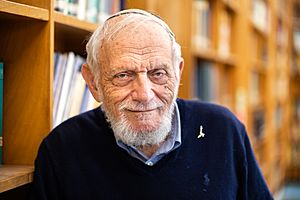Hillel Furstenberg facts for kids
Quick facts for kids
Harry Furstenberg
|
|
|---|---|
| הארי פירסטנברג | |
 |
|
| Born | September 29, 1935 |
| Nationality | Israel American |
| Education | Yeshiva University (BA, MS) Princeton University (PhD) |
| Known for | Proof of Szemerédi's theorem IP set Evenly spaced integer topology Furstenberg–Sárközy theorem Furstenberg boundary Furstenberg's proof |
| Awards | Abel Prize Israel Prize Harvey Prize Wolf Prize |
| Scientific career | |
| Fields | Mathematics |
| Thesis | Prediction theory (1958) |
| Doctoral advisor | Salomon Bochner |
| Doctoral students | Alexander Lubotzky Vitaly Bergelson Shahar Mozes Yuval Peres Tamar Ziegler |
Hillel "Harry" Furstenberg (Hebrew: הלל (הארי) פורסטנברג; born September 29, 1935) is a famous mathematician. He was born in Germany and is now an American-Israeli professor. He taught at the Hebrew University of Jerusalem for many years.
Professor Furstenberg is known for using ideas from probability theory (the math of chance) and ergodic theory (the math of systems that change over time) to solve problems in other areas of math. These areas include number theory (the study of numbers) and Lie groups (a type of math group). He has won several big awards, like the Abel Prize and the Wolf Prize in Mathematics.
Contents
About Hillel Furstenberg
Hillel Furstenberg was born in Germany in 1935. His family was Jewish. In 1939, they had to leave Germany to escape the Holocaust. They moved to the United States and settled in New York City.
Hillel was a very smart student. He went to Yeshiva University and finished his first two degrees (BA and MSc) by the time he was 20. Even as a college student, he wrote important math papers. One of his most famous early papers was about proving that there are infinitely many prime numbers. He used a new and clever method called a topological proof.
His Journey in Math
After college, Furstenberg went to Princeton University for his PhD. He earned his doctorate in 1958. His main area of study was "Prediction Theory."
He worked at the Massachusetts Institute of Technology for a year. Then, in 1961, he became a professor at the University of Minnesota. In 1965, he moved to Israel to join the Hebrew University of Jerusalem. He taught there until he retired in 2003.
Many students learned from Professor Furstenberg. Some of his well-known students include Alexander Lubotzky, Yuval Peres, and Tamar Ziegler.
Awards and Honors
Professor Furstenberg has received many important awards for his work:
- In 1993, he won the Israel Prize, which is one of Israel's highest honors.
- He also received the Harvey Prize in 1993.
- In 2007, he was awarded the Wolf Prize in Mathematics.
- In 2020, he shared the Abel Prize with Gregory Margulis. This award is often called the "Nobel Prize of mathematics." They won for their new ways of using probability and dynamics in different math fields.
He is also a member of important science groups, like the Israel Academy of Sciences and Humanities and the U.S. National Academy of Sciences.
His Amazing Math Discoveries
Hillel Furstenberg is famous for many big ideas in mathematics.
Proving Infinite Primes
One of his first big achievements was in 1955. He found a unique way to prove that there are an endless number of prime numbers. Prime numbers are numbers like 2, 3, 5, 7, that can only be divided by 1 and themselves. His proof used a special area of math called topology.
Random Walks and Group Structures
Starting in 1963, he began to explore how "random walks" (like a random path taken on a grid) on a math group are connected to the group's structure. This led to something called the Furstenberg boundary. His work has been very important for studying different types of math groups.
Disjointness in Ergodic Theory
In 1967, Furstenberg came up with the idea of "disjointness" in ergodic theory. This idea is similar to how numbers can be "coprime" (meaning they share no common factors other than 1). This concept has been useful in many areas, including number theory and even how signals are processed.
Szemerédi's Theorem
One of his most famous achievements was in 1977. He used ergodic theory to prove Szemerédi's theorem. This theorem says that if you have a group of numbers that are "dense" enough, you will always find patterns called "arithmetic progressions" within them. An arithmetic progression is a sequence like 2, 4, 6, 8 (where you add the same number each time). His proof was a huge breakthrough and helped other mathematicians, like Ben Green and Terence Tao, prove even more amazing things about prime numbers.
Personal Life
In 1958, Hillel Furstenberg married Rochelle Cohen. She is a journalist and a writer who studies literature. They have five children and many grandchildren.
Selected Publications
- Furstenberg, Harry, Stationary processes and prediction theory, Princeton, N.J., Princeton University Press, 1960.
- Furstenberg, Harry, Recurrence in ergodic theory and combinatorial number theory, Princeton, N.J., Princeton Univ. Press, 1981.
See also
 In Spanish: Hillel Furstenberg para niños
In Spanish: Hillel Furstenberg para niños
- List of Israel Prize recipients

